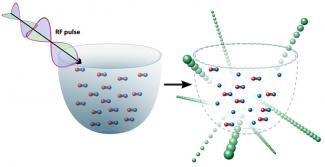The Jin group recently came up with the first strong experimental link between superfluidity in ultracold Fermi gases and superconductivity in metals. What’s more, this feat was accomplished with photoemission spectroscopy, a tried-and-true technique that has been used for more than 100 years to study solids. This technique has been instrumental in revealing the properties of superconductors. It is just beginning to be developed in ultracold Fermi gases, where it could prove to be just as useful.
“The physics of these two systems are approximately the same,” said graduate student Jayson Stewart, who worked with graduate student John Gaebler and Fellow Debbie Jin to develop the new probe. Stewart noted that there are two main differences between photoemission in the two systems: (1) In solids, an electron is photo-emitted, but in an ultracold atom cloud, an atom is photo-emitted. And, (2) the energy of the photons used to probe the systems is very different, with energetic uv photons used to probe solids and low-key rf photons sent poking around the ultracold atoms.
To perform photoemission spectroscopy on ultracold atoms, Stewart and his colleagues first cooled a gas of potassium atoms (40K) in a laser trap to the crossover point connecting superconductivity and Bose-Einstein condensation (BEC). Under these conditions, the atom gas became a superfluid, with nearly all the 40K atoms paired up (one spin up and one spin down) and dancing in sync. Next, the researchers sent an rf pulse into the ultracold atom cloud and, at the same time, turned off the laser trap.
The low-momentum photons in the rf pulse transferred a small percentage of the atoms into another spin state. Even though these atoms were in the same exact place and traveling at the same velocity, they suddenly became completely invisible to their dance partners. The invisible dance partners flew out of the trap and were easily imaged. The remaining correlated atom pairs continued to dance in sync, but in movements governed by the very complicated physics of the system.
In a very cool move, Stewart and his colleagues were able to use the energy and velocity of the escaping spin-flipped (invisible) atoms to determine their energy and velocity when they had been dancing in sync with a partner inside the atom cloud! Likewise, condensed-matter physicists have been able to figure out what an electron has been doing near the surface of a metal superconductor before it gets knocked out by a uv photon.
Suddenly, Stewart and his colleagues had a powerful new tool at their disposal. They decided to use it to compare the physics of their superfluid gas with the physics of superconductivity.
Before they focused on comparing superfluidity and superconductivity, they wanted to test their spectroscopy technique on molecules. To do this, the researchers adjusted the magnetic field in their trap to convert their paired atoms into molecules. They soon found an energy gap between the behavior of their molecular gas and an ideal Fermi gas. Back in 2004, the group had measured a similar gap and found it to be approximately equal to the energy required to break apart the molecules back into atoms.
Next, the researchers readjusted the magnetic field to move the ultracold gas cloud to the crossover point, where the physics of superfluidity was expected to be similar to that of superconductivity. In this experiment, the researchers also discovered a gap, or possibly a pseudogap, between the behavior of an ideal Fermi gas and the superfluid gas filled with atom pairs dancing in sync. Such a gap could be important evidence of the complex physics, including correlated pairing at a distance, thought to play a role in both superfluidity and superconductivity.
However, the “superfluid” gap has turned out to be something like a holy grail for ultracold Fermi atom gases. In 2004, researchers in Innsbruck, Austria, claimed to have found and measured it. Soon, the grail disappeared in response to multiple theoretical demonstrations that the interpretation of the 2004 data did not support the claim of finding it. Now, researchers around the world are once again chasing the holy grail.
So, has the Jin group found it? The jury is still out. The new photoemission spectroscopy technique is a much better method for identifying and measuring a superfluid gap, according to Stewart. However, because he and his colleagues did their photoemission spectroscopy experiments just at the temperature when a superfluid first forms, they can’t be sure that what they observed is the gap. To be sure, they must repeat their experiments at colder and colder temperatures to see if the real gap appears in their data as a function of temperature. - Julie Phillips




